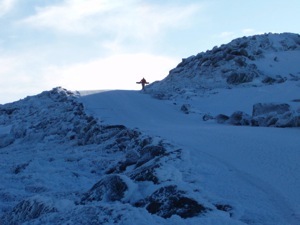December 16, 2009


By Marty Basch
Packed powder, frozen granular and machine groomed are snow conditions familiar to skiers and riders. But what about sastrugi and wind slab?
For backcountry aficionados like Brian Clark and Mike Finnegan those are some of the types of snow they encounter during their upside down ski season which can stretch from late September/October to July.
Clark and Finnegan, both 26, are Mount Washington Observatory weather observers stationed atop wintry Mount Washington. Part of a three-person crew that spends eight days at a time on the Northeast's highest peak gathering data for researchers, the government and other organizations, some of their off-time is spent skiing and snowboarding the slopes, chutes and gullies of Mount Washington.
Clark and Finnegan make their turns in places like the mountain's East Snowfields above legendary Tuckerman Ravine and the Great Gulf not far from the concrete Sherman Adams Summit Building that houses the Observatory’s quarters.
Keep going
"It's really easy to keep going," says Clark about starting the run from a top of the mountain. "You have to put it in the back of your mind that you have to hike back up."
Clark's a lifelong skier and a PSIA certified instructor who learned his turns on Tussey Mountain, a small ski hill outside his hometown of State College, Pa. He's taught at Attitash. Clark skis on Alpine equipment including regular ski boots which he will hike in to get back to the observatory.
"They're a little heavier than Alpine mountaineering boots, but the ankle support is nice," he said.
Ride it
Finnegan rides the mountain on his split snowboard, which allows him the opportunity to ski tour on traverses
and such. He rides in mountaineering boots and brings along crampons and an ice ax. Boarding since a grom, he grew up in the small town of Irasburg in Vermont's Northeast Kingdom.
"Starting from the top is always interesting because you don't have the opportunity of hiking up what you are riding down first," he says. "You have to be cautious. You can see the avalanche terrain at the top and assess that first. On the flip side, you haven't seen what's one thousand feet down. You have to have a sense of awareness and make wise decisions."
They tackle the mountain together, with comrades like Mount Washington State Park manager Mike Pelchat (several organizations operate on the summit including the state, Observatory, Cog Railway and Auto Road) and alone.
When alone, they carry radios since the mountain doesn't have rescue personnel nearby like during the spring skiing season at Tuckerman Ravine.
The runs
The East Snowfields are generally wide slopes with about 1,000 feet of vertical down to the Alpine Gardens. It's a simple schuss from the top between parking lots and then a traverse.
The Great Gulf is more remote and a longer traverse from the summit. The ravine can hold snow into summer and has rocky, narrow runs like Turkey Chute, Airplane Gully and Pipeline Gully.
"There are a lot less people in the Gulf," says Finnegan. "It's quieter and more remote."
(Skiing the Auto Road, also on the summit, requires a pass and is open only to free-heelers.)
Conditions always change on the mountain from clear to whiteout. Storms generally come from the west and northwest filling in bowls. The wind can scour the snow away too. There is ice, corn snow, concrete and the rare epic snow day with shin deep powder. There is sastrugi—windswept irregular grooves of snow that you might imagine on the South Pole—that can make balancing tough. Wind slab snow is akin to whales of manmade snow, hard but edgeable.
Ski the parking lot
Working on the summit has its insider runs too. Finnegan has gone out on the flat 150-foot long observation deck outside the Observatory’s facilities in 60 mile per hour winds and lets the gusts push him across while on his board. Clark will take quick turns in "Parking Lot Gully", a small slope next to a well-known set of summit stairs.
Of course, there are classic spring days and a top-to-Pinkham Notch 4,000-plus vertical foot run from the summit through the snowfields, over the headwall, through Tuckerman and down the John Sherburne Ski Trail is irresistible.
"You have to do that at least once," says Clark.
But always remember the mountain.
"Riding here is a privilege," says Finnegan. "This is a place to test your limits and be prepared."

Courtesy photo of Brian Clark

Photo of Mike Finnegan by Marty Basch


